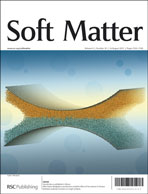Electric field induced pearling instability in cylindrical vesicles
Abstract
A theoretical and experimental study on the effect of an electric field on a cylindrical vesicle is presented. Experiments show that a cylindrical vesicle when subjected to an axial electric field, displays an axisymmetric pearling instability (the Rayleigh–Plateau instability) beyond a threshold electric field. Unlike fluid jets, in which electric fields are known to stabilize the Rayleigh–Plateau instability, cylindrical vesicles exhibit dual effects of electric field. The tension required to induce the instability is produced by the electric field. At higher values of field strength however, a stabilizing action of the electric field is seen. This renders the fastest growing wavenumber, km, independent of the electric field at high electric field strength. Theoretical results predict, albeit qualitatively, a weak dependence of km on the electric field. It also explains the substantially higher experimental values of km (around 0.64–1.0) observed in vesicles as compared to km = 0.56 for fluid cylinders. Theory and experiments show that the instability is induced using a much lower value of pulsed DC field as compared to an AC field. At long times, a pearled state is observed, with the pearls separated by short cylindrical nanotubules. The pearled structure is converted into crowded, taut spherical globules, which are connected by very thin short bilayer cylinders when the field is switched off, before they eventually disappear and the original cylindrical vesicle is recovered. All of the morphological changes in cylindrical vesicles in electric fields are completely reversible. This study demonstrates the dominance of tension and stretching at short and long timescales respectively.


 Please wait while we load your content...
Please wait while we load your content...